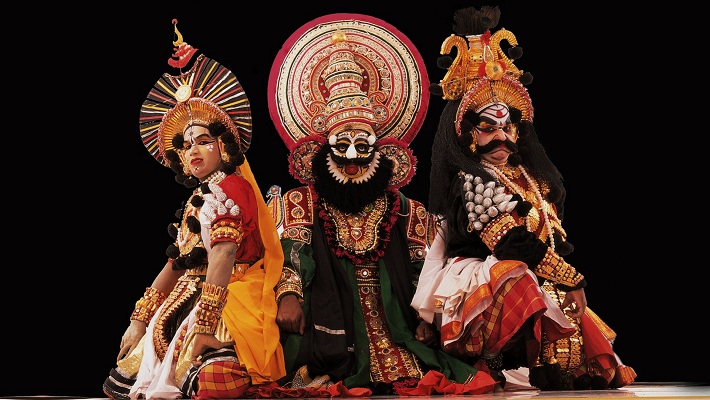
I was impressed by the storyline, direction, and plot of the Kannada film Kantara, but my interest about the folk dance style Bhutha Kola that was portrayed in the film prompted me to learn more about several Karnataka traditional dance forms.
Here are 8 folk culture of Karnataka you need to know about:
Puja Kunitha (Pooja Kunitha)
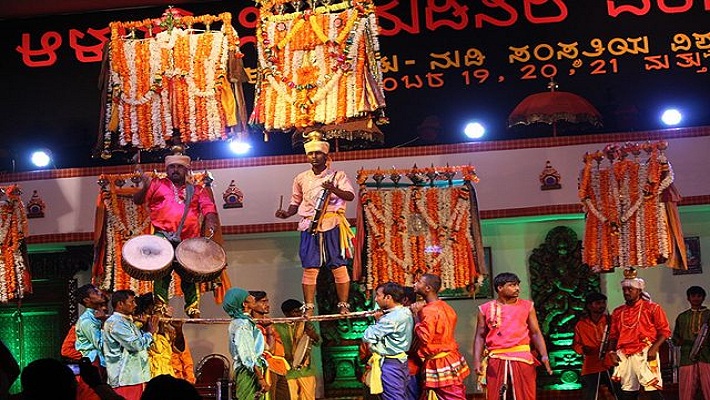
A ritualistic dance for worshipping the goddess Shakti in all of her incarnations, Puja Kunitha is a traditional dance form that is practiced in the Bengaluru and Mandya districts.
This dance is a visual treat at all religious ceremonies for Goddess Shakti, including festivals, processions, and fairs. In this form, the dance is exhibited or represented more visually than it is described orally while being performed.
The use of elaborately adorned bamboo poles in this dance's performance, which sways to the music, makes it special. In large wooden structures, the dancers also carry an idol of Shakti above their heads.
Dollu Kunitha
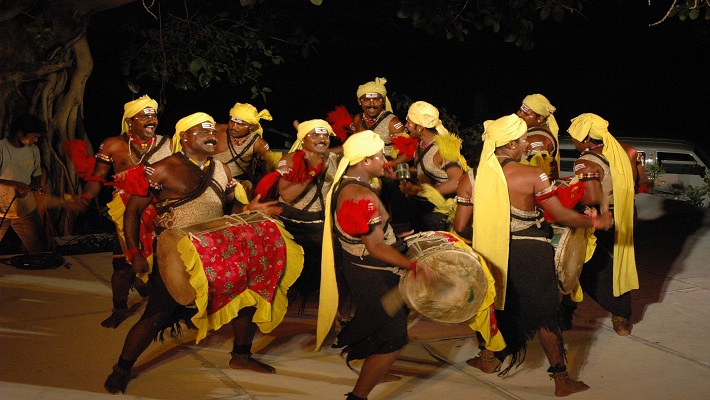
The Dollu Kunitha is one of the ritualistic dances that are popular with the Kurubas of the "Beereshvara Sampradaya," and is regarded as one of Karnataka's Kunitha. This is a highly well-known type of Karnataka dance, in which the dancers sing along to the beat of the drums. The drums are embellished with either flowers or color. This dance is exclusive to the men of the shepherd community (Kuruba community). The Dollu Kunitha is distinguished by loud drumming, swift dancing, and coordinated group formations.
Yakshgana
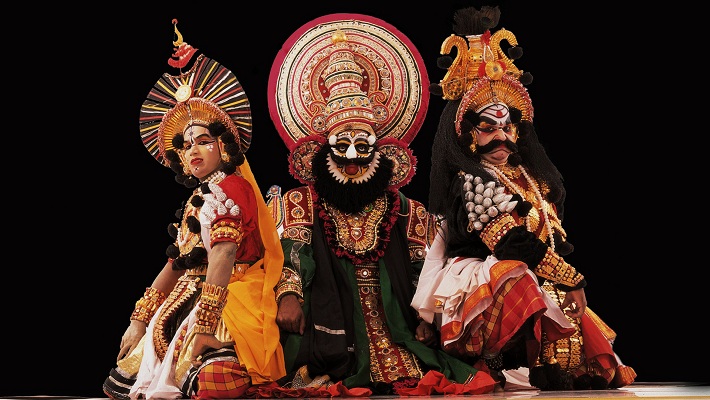
A traditional type of theatre from Karnataka is called Yakshgana. Many of the customs and practices of Sanskrit theatre or play are related to it, especially those of the Purvaranga and the presence of the character Vidushak.
The first Yakshgana play was composed in Telugu and was titled Ganga Gauri Vilasam in the 16th century by Peda Kempa Gaudan. Next came the Renaissance, which was followed by the 17th century, during which Karnataka, Andhra Pradesh, and Tamil Nadu saw the development of the Yakshgana form. This folk art has been practiced in Andhra Pradesh since the 15th century and is presented as both a narrative song and a dance drama. The Prabandha Natak, which emerged in a slightly later era, was likewise connected to the form. Yakshgana, however, did not regain popularity in a dramatic form until the 18th century. Up to that point, plays were written, but primarily as presentation scripts. During a period of significant political instability and social unrest, Yakshgana emerged as a fully developed theatrical form in south Kannada.
Kangadilo Kunitha
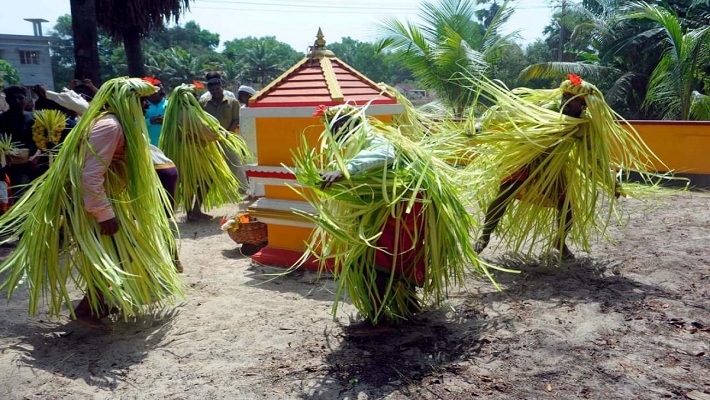
Traditional Kangadilo Kunitha is a type of Tulu dance from Karnataka. Men typically perform this. The garments are embellished with delicate coconut palm leaves. Also worn are flower garlands. Drums and flutes, among other musical instruments, are employed. While one important performer, who typically plays an elderly person, drives the drama, five to seven dancers move in sync. Typically, this person has a white mustache and hair.
Bhutha Kola
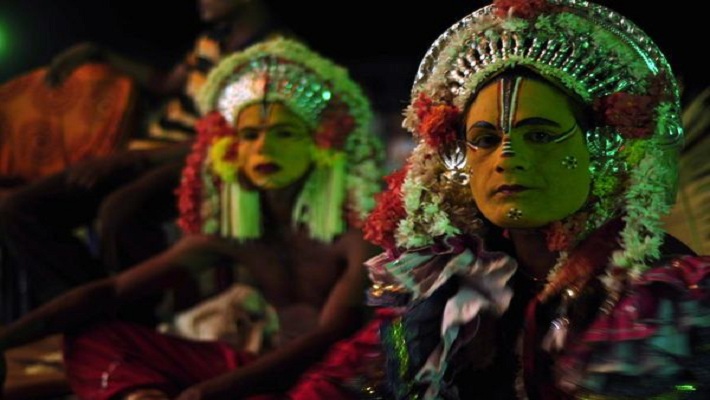
Bhutha kola is an antiquated kind of ceremonial worship that is practiced by the Tulu-speaking population in Udupi, the South Kanara districts of Karanataka, and Kasargod Taluk in Kerala, also known as "Tulu-Nadu." The term "Bhutha" in coastal Karnataka (Dakshina Kannada District, India) refers to a holy spirit that requires regular obeisance. The cult has been practiced for generations. According to the socioeconomic structure of the culture, "Bhutha" rituals vastly differ from village to village. The ritual dance of the spirit impersonator is called "Bhutha Kola," which is a highly stylized and creative rendition that draws in the entire audience. The welfare of a person who has taken vows of dedication to religious service is thought to be able to be shaped by "Bhuthas," according to popular belief. The "Bhutha" cult has its priest class and impersonators who pretend to be the heavenly spirit and act as conduits for prophesy or oracle contact. Different forms of folk music are played during "Bhutha" devotion and an impersonator dances while wearing a bulky anklet called a "Gaggara" and holding a "Chaury" in his hand (Yak tail fan). A metal or areca-leaf mask is worn on the head by an imposter. During the performance, Bhutha or the heavenly spirit has their myths or epics chanted.
Aati Kalanja
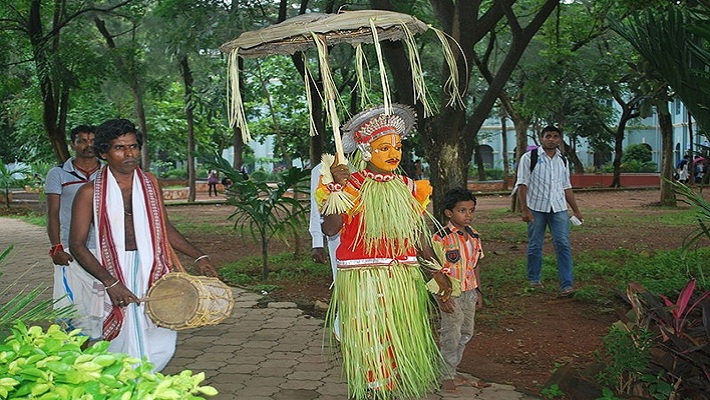
The "Nalke" Community performs the ritualistic folk dance known as "Aati Kalanja." A minor ghost by the name of Kalanja is in charge of guarding the villagers throughout the monsoon season of July and August. A member of the Nalke community dons a costume made of tender coconut leaves, anklets, vibrant clothing, and a long cap made of Areca spate, paints their face with various hues and patterns, and holds an umbrella embellished with leaves and flowers as part of a ritual in which they assume the form of the Bhutha "Spirit" known as Kalanja. The artist then dances in front of each house as he and his drummer aide tour the village. They are rewarded by the householders with rice, coconuts, turmeric, and other items. It is said that by paying homage to the Kalenja in this way, all evil spirits will be banished from the village. According to legend, Kalenja guards the village(s) against bad spirits. As a result, during the rainy season, the people enjoy the impersonator of Kalenja.
Somana Kunitha
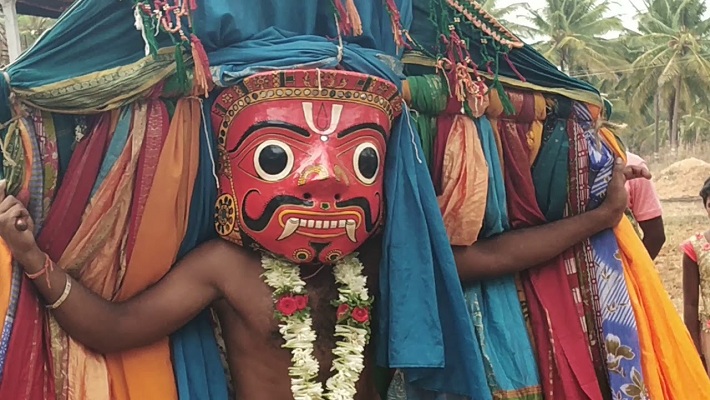
Two or three dancers wear elaborate masks as they execute the ritualistic dance known as Somana Kunitha (also known as Somana Kunita). This dance is only performed by men, who are known as Somas. It is presented in South Karnataka's Mandya, Mysuru, Hassan, Tumakuru, and Bengaluru districts. These dances are often only performed by members of the Okkaliga, Lingayata, Besta, and Kuruba tribes. Participants from Dalit groups perform the instruments. They are given the responsibility of both protecting and worshipping the local deities. According to tradition, Somas are disgruntled followers who, after passing away, took on the role of the local deity's protectors. The origin of the first Somas is the subject of numerous stories. The performers embody this idea in their performance.
The masks worn by the performers are known as somas. These masks only cover the dancer's head; the rest of their body is concealed by either a tight pair of pants or an improvised skirt created from the deity's saree. The size of the masks is over four times that of a human head. One of the Somas is crimson and is quite mesmerizing. The dancer wearing it is referred to as a "Kempanna" or "Papanna." A different mask is yellow and has a muted expression. Iranna or Kenchamma are the names of this Soma. There is occasionally a third Soma who wears a blue mask and goes by the name "Kariraya." One can see a triangular cane-woven structure draped in multicolored sarees behind this mask. The word "banka" refers to this cane building. Through the holes drilled in the mask's nose, the artist can see the outside world. Numerous anklets, breast bands, and other pieces of jewelry fashioned of brass and silver are worn by the performers.
Veeragaase

A popular traditional dance is called Veeragaase. It is a representation of symbols of the bravery and courage of God Veerabhadra. During festivals, particularly in the Hindu months of Shravan and Karthika, this dance is done. It is an aggressive dance with motions that drain your energy that is based on Hindu mythology.
The dancers apply Vibhooti to their foreheads, earlobes, and eyebrows before donning a white turban, kaavi-colored dhotis, Rudrakshamala, and Nagabharanas. They also wear a wooden plaque of Lord Veerabhadra on their chest. A martial dance is performed by the dancers to the beat of the Karadi and chamel drums while holding an unsheathed sword in the right hand and a wooden plaque of Veerabhadra in the left. Typically, the dance group has two, four, or six individuals. A large decorative pole called Nandikolu, which has an orange flag at the top, is hoisted by one of the dancers as the main singer of the group narrates the "Daksha yajna" legend. Traditional percussion instruments called Sambal and Dimmu provide music for the dance. Additionally, a needle is ritualistically pierced across the mouth throughout the dance.
There are many more Karnataka folk dances that I was unable to display, but if you know of any others, please let me know.







